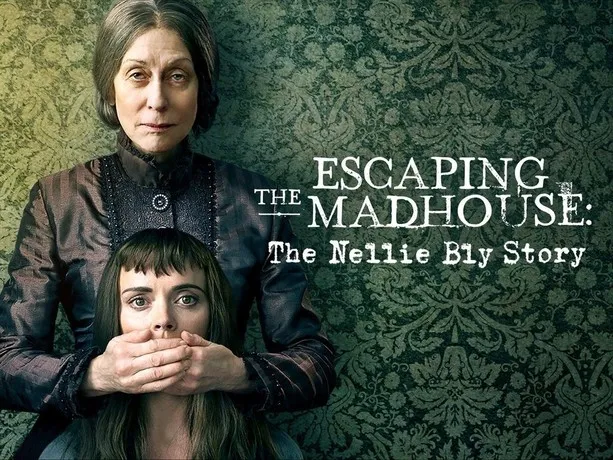Escaping the Madhouse: The Nellie Bly Story (2019) is a gripping historical drama that brings to life the remarkable journey of Nellie Bly, a pioneering journalist known for her groundbreaking undercover investigation into the treatment of mental patients in the 19th century. Directed by Micho Rutare and starring Christina Ricci as Bly, the film tells the true story of how Bly infiltrated the notorious Blackwell's Island Insane Asylum in New York by pretending to be mentally ill. The film is not just a recounting of Bly’s audacious mission but a powerful exploration of courage, justice, and the personal cost of seeking truth. As Bly navigates the brutal conditions within the asylum, her determination to expose the horrors faced by women institutionalized for trivial reasons sets the stage for a dramatic transformation in mental health care and journalism. The film begins by introducing Nellie Bly, a young and ambitious journalist who is eager to make her mark in a male-dominated field. In the 19th century, women were often relegated to traditional roles, but Bly was determined to break barriers. She is assigned to investigate the conditions of mental asylums, a subject that was poorly understood and largely hidden from the public eye. Inspired by the challenge, Bly embarks on a bold plan to expose the inhumane treatment of the patients by feigning insanity and committing herself to Blackwell's Island Insane Asylum. The decision to go undercover is fraught with risk, and the film emphasizes her meticulous planning, highlighting her unwavering commitment to the truth, despite the severe personal and professional risks involved. Her fearlessness is evident, knowing that her entire career and well-being could be jeopardized by this dangerous undertaking. The early stages of the film showcase Bly's determination and the personal sacrifices she makes, including her separation from family and friends, as she embarks on this life-altering journey.

Once inside the asylum, the narrative shifts to a tense and harrowing experience as Bly witnesses firsthand the shocking conditions that the patients endure. Blackwell’s Island Insane Asylum was infamous for its overcrowded rooms, filthy conditions, and cruel treatment by the staff. The patients, mostly women, were often committed for trivial reasons, such as disobedience or emotional distress, and many were subjected to physical abuse, neglect, and inadequate medical care. Bly's undercover role as a patient allows her to observe and document the shocking abuses, but it also places her in grave danger. She faces harassment and mistreatment from the staff, and at times, it becomes difficult to distinguish her role as a reporter from the terrifying reality of her situation. The film captures the emotional and psychological toll that the asylum’s harsh environment takes on Bly, who, despite her growing anxiety and fear, remains resolute in her mission. The scenes inside the asylum are both disturbing and emotionally charged, illustrating the desperation of the patients and the severity of the injustices they faced. As Bly continues to gather evidence of the asylum’s mismanagement and abuse, the narrative builds toward her eventual escape. The conditions she witnesses inside the asylum weigh heavily on her, and the emotional turmoil she experiences is evident throughout the film. With the help of a sympathetic ally, Bly manages to escape after spending ten days inside. The tension in these scenes is palpable, as Bly must navigate the dangers of the institution and find a way to break free without alerting the authorities to her true identity. Upon escaping, Bly is determined to expose the grim reality of the asylum to the world. The film emphasizes the powerful impact of her exposé, which revealed the appalling conditions and the mistreatment of patients in great detail. Bly’s work not only shocked the public but led to significant reform in the treatment of the mentally ill, influencing changes in both the legal system and public perceptions of mental health care. The courage Bly demonstrated in bringing attention to the suffering of countless individuals made her a trailblazer in investigative journalism.

In the final act of the film, the focus shifts to the lasting impact of Bly’s investigation and the broader implications of her work. The exposure of Blackwell’s Island Insane Asylum led to immediate changes in the way mental health institutions were monitored, forcing reformers to demand better conditions for patients and more oversight of such facilities. The public outrage that followed Bly’s report played a pivotal role in the transformation of mental health care practices, as well as in opening the door for more women to pursue careers in journalism. The film concludes by showing the lasting legacy of Bly’s work, not only as an advocate for mental health reform but also as a trailblazer in the field of investigative journalism. Her story serves as an inspiring reminder of the power of the press to challenge injustice and bring about social change. Escaping the Madhouse: The Nellie Bly Story is a powerful film that honors the courage and determination of one of history’s most significant journalists. Through vivid performances and an emotionally charged narrative, the film captures Bly’s bravery and the toll her investigation took on her both physically and emotionally. Christina Ricci’s portrayal of Bly is compelling, capturing the essence of a woman who was unafraid to challenge societal norms and expose uncomfortable truths. The film not only tells the story of a remarkable woman but also sheds light on the broader issues of mental health and the importance of investigative journalism in holding institutions accountable. Ultimately, Escaping the Madhouse is a tribute to Nellie Bly’s indomitable spirit and her legacy as a pioneer who used her voice to make a difference in the world.




